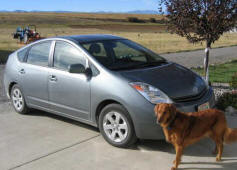
Search
The Renewable Energy site for Do-It-Yourselfers
1/2 -- Transportation Projects
|
This page describes our massive and
complex plan for cutting energy use for automobile transport -- we bought
a Prius. Some things just turn out to be easier than you thought
they would be.
The totals to date for Transportation
Projects are:
23,900 KWH/yr energy saving
6.0 tons/yr reduction in carbon
dioxide emissions
Total cost of projects $3000
First year return of 62%
|
|
| Bought A Toyota Prius Hybrid |
| We bought a Toyota
Prius hybrid more than a year ago.
This has been our single most effective change. It accounts for
more than a third of our total GHG reduction. And, It is a great car
to own and drive.
It has also a great investment.
More
information
Hybrid Calculator |
 |
| Energy Saving/yr |
23900KWH |
Initial Cost |
$3000 * |
DIY Labor |
0 hrs |
| CO2 reduction |
11900 lb |
$'s Saved/year |
$1880 |
DIY difficulty |
0 |
| Energy Source |
Gasoline |
1st Year Return |
62% |
|
|
| |
|
10 yr saving (10% fuel inflation per year) |
$29950 |
|
|
Cost Estimate:
The Prius replaced a very old Outback that was past due. I used $3000
as an estimate of the premium we paid for the hybrid feature (including some
tax rebates). In a
way, I'm not sure it was fair to charge this against the hybrid, because the
other cars we were considering were just as expensive as the Prius, they
just had different feature sets (e.g. 4WD instead of the Hybrid power
plant).Dollar Saving:
I did the cost saving by comparing what it would have cost to put the miles
on our Honda Pilot (a relatively good mileage, car based SUV) instead of
the Prius. This may or may not be the way some would do it, but for us
it is reality -- if we don't drive the Prius we are going to be driving the
Pilot.
This turns out to be 324 gallons for the Prius for the year, rather than 951
gallons for the Pilot. A saving of 627 gallons, or $1880 at $3 per
gallon. I used this Hybrid Calculator
for both fuel and GHG saving.
This is for 18000 miles per year, which is just about exactly what we have
actually driven the Prius. * This is an estimate of the premium that we
paid for the Prius hybrid features over a non-hybrid car. It includes
the effect of the 2005 MT and federal tax rebates. |
| Drive Less |
| We drive to much, and
we are trying to drive less. So far, we have not had a lot of success, but
I do think we are headed toward doing better.
Bozeman is getting transit (at last), and I am seriously thinking about
doing some from of
Don's electric PV scooter for little runs into town.
More information |
 |
| Energy Saving/yr |
0 KWH |
Initial Cost |
$0 |
DIY Labor |
0 hrs |
| CO2 reduction |
0 lb |
$'s Saved/year |
huge potential |
DIY difficulty |
100 |
| Energy Source |
Gasoline |
1st Year Return |
huge potential |
|
|
| |
|
10 yr saving (10% fuel inflation per year) |
huge potential |
|
|
Cost Estimate:
Zero.Dollar Saving:
The dollar saving could be huge, but, so far, nothing for us.
|
Green House Gas Emissions:
Green House Gas gas reductions were
estimated like this.
DIY Difficulty:
In the project descriptions, "DIY difficulty"
is a 1 to 10 rating of how hard the project is to do yourself: 1 being
very easy, and 10 being "No chance I'm ever doing that again".
Economics:
There are a lot of ways to do a good
job of calculating economic return -- Internal Rate of Return (IRR), Life Cycle
Costs, ... I think most of these just go right over peoples heads, so I
decided on three less accurate, but very simple indicators: 1) dollars saved in
fuel in the first year, 2) first year rate of return, which is just (first
year $ saving/cost of project), and 3) 10 year fuel saving with 10% rise in fuel
prices each year. I think these give a pretty good feel for how good the
project is economically without requiring an econ degree to understand? If
you have a suggestion for a better way, I'd like to hear it.
10 Year Cost Saving:
The "10 year saving" uses a fuel
inflation factor of 10% per year. This may be higher that what we will
actually experience, but I used it as a measure of what would happen if fuel
prices continue to go up at a high rate. If you would like to use another
factor, here are some others:
For 15% per year increase, multiply
the first year saving by 20.30
For 10% per year increase, multiply
the first year saving by 15.93
For 8% per year increase,
multiply the first year saving by 14.49
For 5% per year increase,
multiply the first year saving by 12.58
For 3% per year increase,
multiply the first year saving by 11.46
For 0% per year increase,
multiply the first year saving by 10.00
Gary 08/02/06


